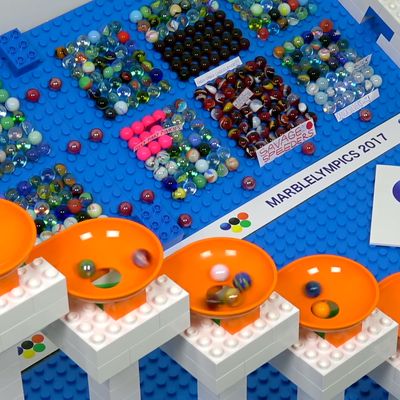
Earlier this week, the Norwegian musher Thomas Wærner won the 2020 Iditarod, the legendary dogsledding race that, like every other sporting event this year, has become a casualty of the coronavirus. Many mushers did not end up finishing the race, as various checkpoints along the 1,000-mile route were shut down early to help contain the possible spread of the pandemic. After winning, Wæerner had to teleconference with his wife, who flew back to Norway early to avoid potential travel restrictions.
The end of the Iditarod marks the end of professional sports as we know them, for the time being. March Madness is canceled, the NBA season has been suspended, baseball has been postponed eight weeks. There are, to my mind, only two options left for watching sports. First, there are e-sports, the competitive video game leagues for popular shooters like Overwatch or Call of Duty, or strategy games like League of Legends.
The other option — the better option — is watching marble races on YouTube.
If for some reason you don’t know what a marble race is, the concept is very simple to grasp. A group of marbles are sent down a track and the first marble to the finish line wins. That’s it.
The marble videos on YouTube, aside from being mesmerizing, have a strong betting component as well. At the start of each video, the viewer is presented with all of the competing marbles. They each have a funny name, like Garland or Turtle (that marble has a turtle in it). The viewer then selects one marble they think will win. “I’m going with Reflector.”
Then, the race starts. For the next few minutes (minutes! These are very long marble races!) you sit transfixed, hoping that your marble will pull into the lead. Many races have a consistent leader, but you will soon learn that being out front early is no guarantee. The leaders almost always get snagged on a bump or divot.
The videos, on a visceral level, are transfixing. They balance on the razor’s edge of gratifying and frustrating. Some races take place on long, elaborate tracks carved in sand or snow, some happen on plastic toy tracks. Some races have no track, just an enormous funnel that the couple dozen spheroids circle for what seems like infinity. They are objects of pure physics and gravity with no human interference or conscious thought. When you bet on a marble race, you bet against the Gods themselves.
Aside from the lizard-brain-scratching pleasure of a marble rolling along, there is a surprising amount of worldbuilding that some marble-racing channels exercise. Jelle’s Marble Runs, for example, includes color commentary on each race. It also organizes tournaments (again, these are marbles) such as Marbula 1 and the Marble League (formerly known as Marblelympics), which included an opening ceremony and lighting of the flame.
“Even though it’s without humans, we still see the same sort of stories that draw people to sports in general where we see underdog stories and great comebacks and and the push to be the best that you can be,” Greg Woods, who provides color commentary for the popular YouTube channel Jelle’s Marble Runs told me over the phone. JMR also has a thriving Reddit community tabulating the standings for different tournaments, its users separated into factions based on the teams and specific marbles that they prefer.
Over Twitter DM, the user @RedNumber3Fan explained to me, “It’s really sort of a thrill to see a marble make a run to pass those marbles ahead of it. There seemed to be a group in the Rallies that tended to perform better, on average, and it wasn’t long before I felt I had gotten to ‘know’ them.”
As for the appeal of Red Number 3 specifically? “It was pretty natural to become a fan of Red Number 3, especially following its rookie year (2017) when it just missed the overall title and seemed to run with a sort of abandon.”
A fun activity for if you are trapped inside is to put on a marble race compilation video (the Marble League clip up there is more than an hour and a half long) and place some bets. It’s a good way to kill time. If you’ve got a decent internet connection, do it on a streaming video service or screen-sharing software so everyone’s viewing is synced up. Even absent of that, JMR gives viewers a new contest to look forward to every week.
“But!” you say, “Can’t people just skip to the end of the video and cheat?” The answer is yes. Also: anyone who does that is not your friend. To cheat on marble bets is to violate the social contract we have made with one another in these dire times.
An increase in stir-crazy sports fans has led to a significant uptick in marble-racing fans. One clip that went viral on Twitter led to more than 26,000 new subscribers, according to Woods. “People are looking for something to share their enthusiasm about to get back into that rhythm. They’re missing that,” he said. “And if we can play a little part in providing something that can help in the meantime, then we are thrilled to do it.” ESPN2, starved for content, is rerunning its obscure sports block ESPN Ocho this weekend, including a series of marble races from JMR.
And while marble racing lets people continue to role-play as sports fans, it contains far less toxicity too. As @RedNumber3Fan put it, “The fans are incredibly good-natured and generous with their praise of other teams and their fans. That might be due in large part to the fact that there’s no one to ‘blame’ when a marble loses a race.”





























